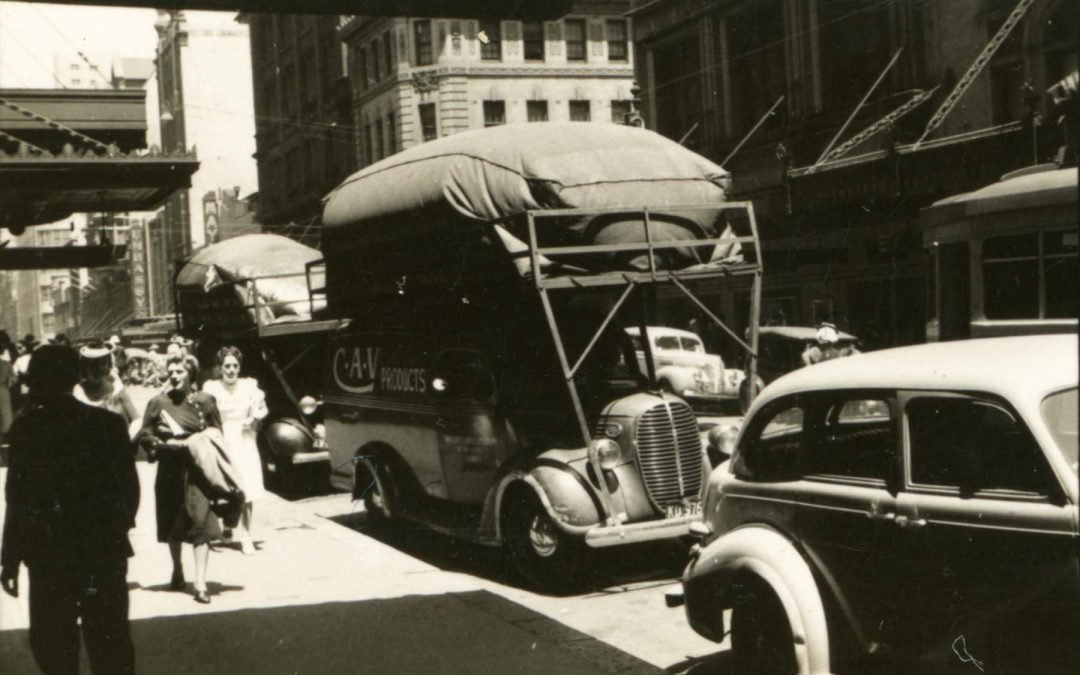Rationing in Queensland
During the Second World War (1939 – 1945), Australia, in common with other Allied nations, rationed important commodities, including food, petrol, rubber, and clothing. Australia implemented rationing for a variety of reasons, including reduced imports, a smaller labour force, the urgent need to provision Australian and Allied troops, trade agreements with the Great Britain, and concerns about inflation. Rationing in Australia was never as severe as in Britain, whose supply chains were heavily impacted by the German blockade of the North Atlantic. As Australia was less reliant on imported produce, domestic farming supplied much its food.
Wartime (c. 1944) photo of a Brisbane street corner, possibly Edward and Queen or Adelaide Street
Australia began to ration food and clothing in 1942, with each adult citizen receiving a ration book containing an annual supply of coupons. Ration coupons were required for the purchase of clothing, sugar, butter, tea, meat, and, intermittently, for the purchase of milk and eggs. In addition to formal rationing, the Australian population was encouraged to plan meals carefully, reuse clothing, forgo cosmetics, reduce consumption of alcohol and cigarettes, and grow their own fruit and vegetables. (The Queensland experience of food rationing was somewhat eased by its large suburban blocks, which allowed many families to grow their own produce.) While frugality was widely viewed as patriotic, there was also a thriving black market dealing in coupons and rationed goods. In Brisbane, which saw a massive influx of American troops, Australia’s strict licensing laws created the conditions for a thriving black market in liquor. Although rationing continued in Britain until the mid-1950s, Australia abolished the rationing of food and clothing following the 1949 election.
Van equipped with gas bags on roof to provide fuel to reduce petrol consumption (Brisbane, c. 1944)
Maintaining Australia’s petrol supply during wartime posed a serious challenge, as Australia was completely reliant on imported petrol and did not possess a significant reserve. Authorities were initially reluctant to introduce petrol rationing due to limited public support. Despite the measure’s unpopularity, the urgency of the situation had prompted the introduction of petrol rationing in 1940. (The immediate result was petrol hoarding and blistering criticism from the industrial sector.) The public was also encouraged to switch from petrol to gas producers (units which converted charcoal to gas). Gas producers were generally mounted on the backs of cars, the sides of trucks, and the roofs of buses. This measure was also far from universally accepted, as the public was largely unfamiliar with gas producers and the units themselves were cumbersome and often inefficient. Despite the unpopularity of both rationing and gas producers, petrol rationing was only permanently discontinued in February 1950.
See:
Don Bartlett. “Producer Gas and the Australian Motorist: An Alternate Fuel During the “Crisis” of 1939 – 1945.” Engineering Heritage Victoria Guest Speakers’ Series. 21 February 2008. http://consuleng.com.au/Producer%20Gas%20&%20the%20Aussie%20Motorist%201939-45.pdf.
Lorna Froude. “Petrol Rationing in Australia During the Second World War.” Journal of the Australian War Memorial 36 (2002). https://www.awm.gov.au/articles/journal/j36/petrol.
Museum of Applied Arts and Sciences. “Collection of Seven Ration Cards.” Museum of Applied Arts and Sciences. 2019. https://collection.maas.museum/object/397038.
Museum of Applied Arts and Sciences. “Ration Ticket, ‘1 Gallon’, Petrol Rationing, Ink on Paper, Printed by Australian Note and Stamp Printer, Issued by the Commonwealth of Australia, Australia, 1949.” Museum of Applied Arts and Sciences. 2019. https://collection.maas.museum/object/11528.
Judith Powell. “Ervin Task.” SLQ Blogs. 3rd May 2018. http://blogs.slq.qld.gov.au/jol/2018/05/03/ervin-task/.
Reserve Bank of Australia. “Rationing, Austerity and Black Markets.” Reserve Bank of Australia. 2019. https://museum.rba.gov.au/exhibitions/make-your-money-fight/rationing-austerity-and-black-markets/.
Queensland Government. “Rationing.” Queensland WWII Historic Places. 29 July 2014. https://www.ww2places.qld.gov.au/homefront/rationing.



